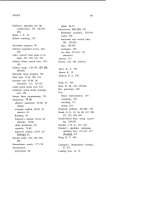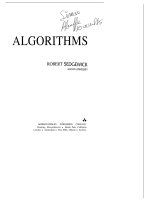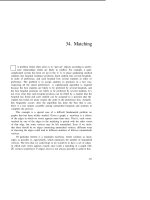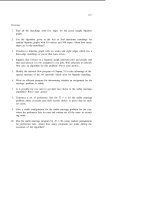Tài liệu Thuật toán Algorithms (Phần 1) doc
Bạn đang xem bản rút gọn của tài liệu. Xem và tải ngay bản đầy đủ của tài liệu tại đây (171.1 KB, 10 trang )
ALGORITHMS
ROBERT
BROWN
ADDISON-WESLEY PUBLISHING COMPANY
Reading, Massachusetts l Menlo Park, California
London l Amsterdam l Don Mills, Ontario l Sydney
To Adam, Brett, Robbie
and especially Linda
This book is in the
Addison-Wesley Series in Computer Science
Consulting Editor
Michael A. Harrison
Sponsoring Editor
James T.
Library of Congress Cataloging in Publication Data
Sedgewick, Robert,
Algorithms.
1. Algorithms. I. Title.
1983
O-201 -06672-6
519.4 82-11672
Reproduced by Addison-Wesley from camera-ready copy supplied by the author.
Reprinted with corrections, August 1984
Copyright 1983 by Addison-Wesley Publishing Company, Inc.
All rights reserved. No part of this publication may be reproduced, stored in
a retrieval system, or transmitted, in any form or by any means, electronic,
mechanical, photocopying, recording, or otherwise, without prior written per-
mission of the publisher. Printed in the United States of America.
ISBN o-201-06672-6
FGHIJ-HA-8987654
Preface
This book is intended to survey the most important algorithms in use on
computers today and to teach fundamental techniques to the growing number
of people who are interested in becoming serious computer users. It is ap-
propriate for use as a textbook for a second, third or fourth course in computer
science: after students have acquired some programming skills and familiarity
with computer systems, but before they have specialized courses in advanced
areas of computer science or computer applications. Additionally, the book
may be useful as a reference for those who already have some familiarity with
the material, since it contains a number of computer implementations of useful
algorithms.
The book consists of forty chapters which are grouped into seven major
parts: mathematical algorithms, sorting, searching, string processing, geomet-
ric algorithms, graph algorithms and advanced topics. A major goal in the
development of this book has been to bring together the fundamental methods
from these diverse areas, in order to provide access to the best methods
that we know for solving problems by computer for as many people as pos-
sible. The treatment of sorting, searching and string processing (which may
not be covered in other courses) is somewhat more complete than the treat-
ment of mathematical algorithms (which may be covered in more depth in
applied mathematics or engineering courses), or geometric and graph algo-
rithms (which may be covered in more depth in advanced computer science
courses). Some of the chapters involve treatment of advanced
material. It is hoped that the descriptions here can provide students with
some understanding of the basic properties of fundamental algorithms such
as the FFT or the simplex method, while at the same time preparing them
to better appreciate the methods when they learn them in advanced courses.
The orientation of the book is towards algorithms that are likely to be
of practical use. The emphasis is on students the tools of their
trade to the point that they can confidently implement, run and debug useful
algorithms. Full implementations of the methods discussed (in an actual
programming language) are included in the text, along with descriptions of
the operations of these programs on a consistent set of examples. Though not
emphasized, connections to theoretical computer science and the analysis of
algorithms are not ignored. When appropriate, analytic results are discussed
to illustrate why certain algorithms are preferred. When interesting, the
relationship of the practical algorithms being discussed to purely theoretical
results is described. More information of the orientation and coverage of the
material in the book may be found in the Introduction which follows.
One or two previous courses in computer science are recommended for
students to be able to appreciate the material in this book: one course in
111
iv
programming in a high-level language such as Pascal, and perhaps another
course which teaches fundamental concepts of programming systems. In short,
students should be conversant with a modern programming language and
have a comfortable understanding of the basic features of modern computer
systems. There is some mathematical material which requires knowledge of
calculus, but this is isolated within a few chapters and could be skipped.
There is a great deal of flexibility in the way that the material in the
book can be taught. To a large extent, the individual chapters in the book
can each be read independently of the others. The material can be adapted
for use for various courses by selecting perhaps thirty of the forty chapters.
An elementary course on “data structures and algorithms” might omit some
of the mathematical algorithms and some of the advanced graph algorithms
and other advanced topics, then emphasize the ways in which various data
structures are used in the implementation. An intermediate course on “design
and analysis of algorithms” might omit some of the more practically-oriented
sections, then emphasize the identification and study of the ways in which
good algorithms achieve good asymptotic performance. A course on “software
tools” might omit the mathematical and advanced algorithmic material, then
emphasize means by which the implementations given here can be integrated
for use into large programs or systems. Some supplementary material might be
required for each of these examples to reflect their particular orientation (on
elementary data structures for “data structures and algorithms,” on math-
ematical analysis for “design and analysis of algorithms,” and on software
engineering techniques for “software tools”); in this book, the emphasis is on
the algorithms themselves.
At Brown University, we’ve used preliminary versions of this book in our
third course in computer science, which is prerequisite to all later courses.
Typically, about one-hundred students take the course, perhaps half of whom
are majors. Our experience has been that the breadth of coverage of material
in this book provides an “introduction to computer science” for our majors
which can later be expanded upon in later courses on analysis of algorithms,
systems programming and theoretical computer science, while at the same
time providing all the students with a large set of techniques that they can
immediately put to good use.
The programming language used throughout the book is Pascal. The
advantage of using Pascal is that it is widely available and widely known;
the disadvantage is that it lacks many features needed by sophisticated algo-
rithms. The programs are easily translatable to other modern programming
languages, since relatively few Pascal constructs are used. Some of the pro-
grams can be simplified by using more advanced language features (some not
available in Pascal), but this is true less often than one might think. A goal of
this book is to present the algorithms in as simple and direct form as possible.
The programs are not intended to be read by themselves, but as part of the
surrounding text. This style was chosen as an alternative, for example, to
having comments. Consistency in style is used whenever possible, so
that programs which are similar, look similar. There are 400 exercises, ten
following each chapter, which generally divide into one of two types. Most
of the exercises are intended to test students’ understanding of material in
the text, and ask students to work through an example or apply concepts
described in the text. A few of the exercises at the end of each chapter involve
implementing and putting together some of the algorithms, perhaps running
empirical studies to learn their properties.
Acknowledgments
Many people, too numerous to mention here, have provided me with helpful
feedback on earlier drafts of this book. In particular, students and teaching
assistants at Brown have suffered through preliminary versions of the material
in this book over the past three years. Thanks are due to Trina Avery, Tom
Freeman and Janet Incerpi, all of whom carefully read the last two drafts
of the book. Janet provided extensive detailed comments and suggestions
which helped me fix innumerable technical errors and omissions; Tom ran
and checked the programs; and Trina’s copy editing helped me make the text
clearer and more nearly correct.
Much of what I’ve written in this book I’ve learned from the teaching and
writings of Don Knuth, my thesis advisor at Stanford. Though Don had no
direct influence at all on this work, his presence may be felt in the book, for
it was he who put the study of algorithms on a scientific footing that makes
a work such as this possible.
Special thanks are due to Janet Incerpi who initially converted the book
into format, added the thousands of changes I made after the “last draft,”
guided the files through various systems to produce printed pages and even
wrote the scan conversion routine for that we used to produce draft
manuscripts, among many other things.
The text for the book was typeset at the American Mathematical Society;
the drawings were done with pen-and-ink by Linda Sedgewick; and the final
assembly and printing were done by Addison-Wesley under the guidance of
Jim The help of all the people involved is gratefully acknowledged.
Finally, I am very thankful for the support of Brown University and
INRIA where I did most of the work on the book, and the Institute for Defense
Analyses and the Xerox Palo Alto Research Center, where I did some work
on the book while visiting.
Robert Sedgewick
Marly-le-Roi, France
February,









